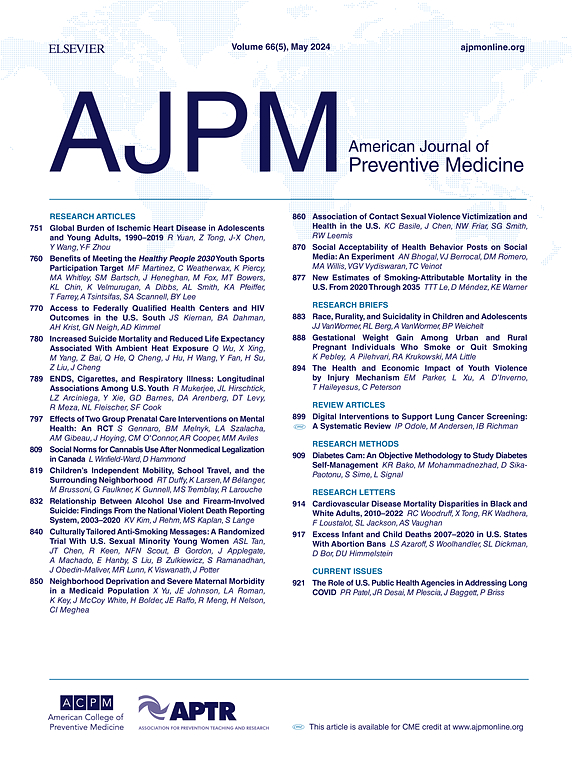同伴欺凌受害对亲密伴侣暴力的短期影响。
IF 4.3
2区 医学
Q1 MEDICINE, GENERAL & INTERNAL
引用次数: 0
摘要
虽然研究已经建立了同伴欺凌受害与伴侣亲密伴侣暴力(IPV)风险增加之间的联系,但大多数研究都是横向的,因此无法解释先前的欺凌经历和欺凌-IPV关系的周期性。本研究的目的是利用2015-2017年的纵向数据,对身体和心理同伴欺凌受害对IPV受害的影响进行强有力的评估,该数据涵盖了加利福尼亚州拉丁裔农业地区青少年从初中到高中的过渡(分析于2025年进行)。我们探讨了身体和心理上的同伴欺凌是否会增加IPV的风险,并评估了可能改变欺凌与IPV之间关系的背景因素,以确定干预目标。为了解释这种时变的混淆,我们使用了顺序条件平均模型。结果:来自同伴的所有形式的欺凌,包括身体欺凌(调整优势比(AOR) 1.77, 95%置信区间(CI): 1.32, 2.37;结论:尽管欺凌和IPV都有反复发生和周期性的经历,但欺凌受害对IPV有短期的直接影响。增加社区成员的社会支持是预防青少年IPV的关键干预目标。本文章由计算机程序翻译,如有差异,请以英文原文为准。
Short-Term Effects of Peer-Bullying Victimization on Intimate Partner Violence
Introduction
Although research has established associations between peer-bullying victimization and increased risk of intimate partner violence from a partner, most research has been cross-sectional and, therefore, unable to account for prior experiences of bullying and the cyclical nature of the bullying intimate partner violence relationship.
Methods
The goal of this study was to provide a robust evaluation of the effects of physical and psychological peer-bullying victimization on intimate partner violence victimization using longitudinal data from 2015 to 2017 that bridge the transition between middle and high school among youth from a predominately Latine agricultural region in California (analysis was performed in 2025). The authors explored whether physical and psychological peer bullying increased the risk for intimate partner violence and assessed contextual factors that may modify the relationship between bullying and intimate partner violence to identify intervention targets. To account for this time-varying confounding, the authors used sequential conditional mean models.
Results
All forms of bullying from a peer, including physical (AOR=1.77; 95% CI=1.32, 2.37; p<0.001) and psychological (AOR=1.58; 95% CI=1.10, 2.25; p=0.01) bullying, similarly increased the risk of intimate partner violence in the short term after accounting for prior experiences of bullying and intimate partner violence. In addition, the authors found that contextual factors, including increased neighborhood disorder and decreased social cohesion, modified the relationship between bullying and intimate partner violence.
Conclusions
There is a short-term immediate effect of bully victimization on intimate partner violence despite reoccurring and cyclical experiences of both bullying and intimate partner violence. Increasing social support from community members is a critical intervention target for preventing intimate partner violence among youth.
求助全文
通过发布文献求助,成功后即可免费获取论文全文。
去求助
来源期刊

American Journal of Preventive Medicine
医学-公共卫生、环境卫生与职业卫生
CiteScore
8.60
自引率
1.80%
发文量
395
审稿时长
32 days
期刊介绍:
The American Journal of Preventive Medicine is the official journal of the American College of Preventive Medicine and the Association for Prevention Teaching and Research. It publishes articles in the areas of prevention research, teaching, practice and policy. Original research is published on interventions aimed at the prevention of chronic and acute disease and the promotion of individual and community health.
Of particular emphasis are papers that address the primary and secondary prevention of important clinical, behavioral and public health issues such as injury and violence, infectious disease, women''s health, smoking, sedentary behaviors and physical activity, nutrition, diabetes, obesity, and substance use disorders. Papers also address educational initiatives aimed at improving the ability of health professionals to provide effective clinical prevention and public health services. Papers on health services research pertinent to prevention and public health are also published. The journal also publishes official policy statements from the two co-sponsoring organizations, review articles, media reviews, and editorials. Finally, the journal periodically publishes supplements and special theme issues devoted to areas of current interest to the prevention community.
 求助内容:
求助内容: 应助结果提醒方式:
应助结果提醒方式:


